บทความ
ทำความรู้จักโทเคน CETUS (Cetus Protocol) แพลตฟอร์มแลกเปลี่ยนแบบกระจายอำนาจ และ Concentrated Liquidity Protocol บนเครือข่าย Sui และ Aptos
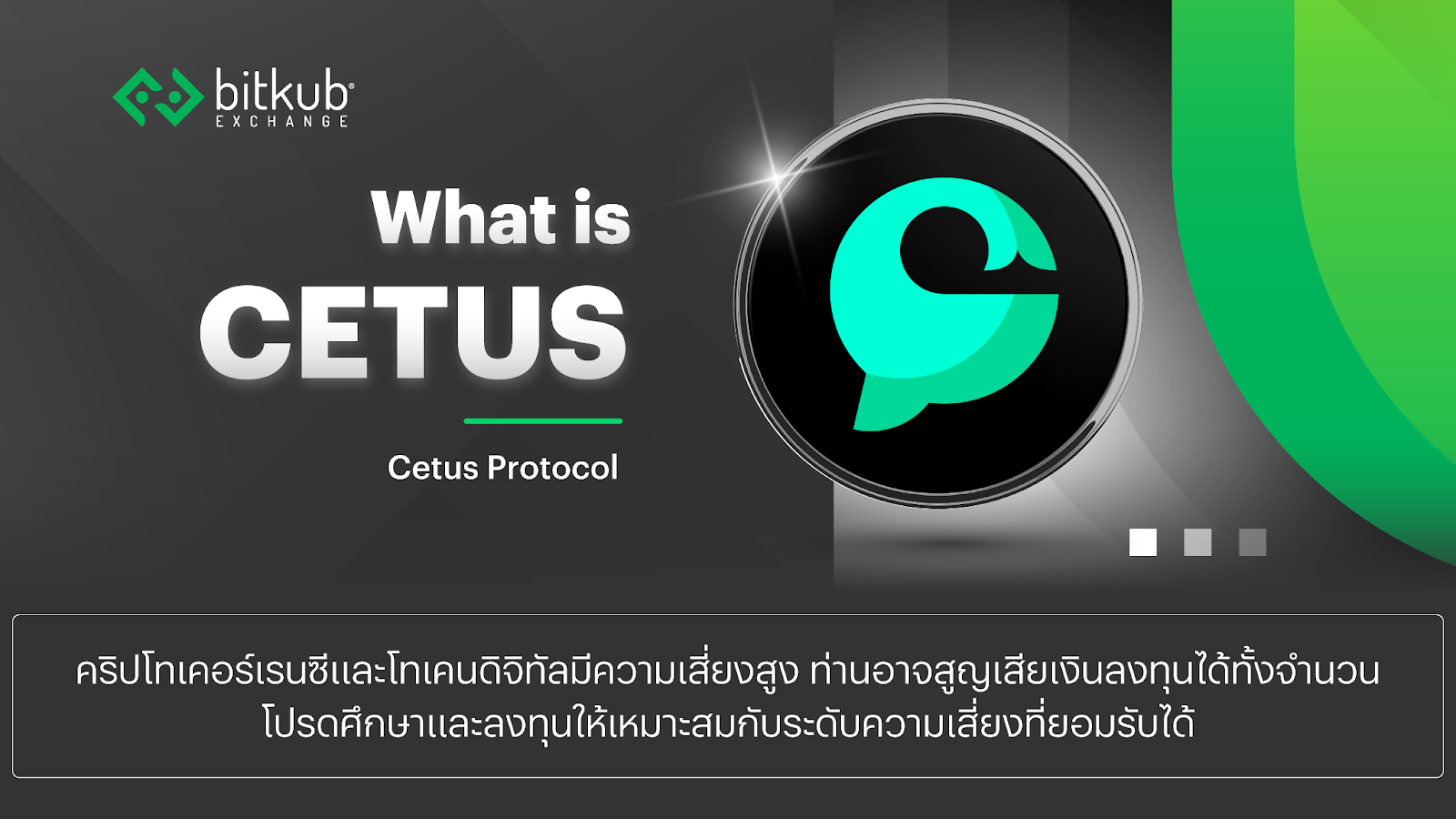
สำหรับผู้ที่สนใจเกี่ยวกับความเปลี่ยนของระบบการเงินแบบกระจายอำนาจ Cetus Protocol ได้กลายมาเป็นผู้เล่นที่สำคัญซึ่งนำเสนอนวัตกรรมสำหรับการจัดหาสภาพคล่องและการซื้อขาย บทความนี้จะพามาทำความรู้จัก Cetus Protocol เข้าใจเทคโนโลยีพื้นฐาน คุณสมบัติเด่น และ โทเคน CETUS
ทำความรู้จัก Cetus Protocol
Cetus Protocol เป็นแพลตฟอร์มแลกเปลี่ยนแบบกระจายอำนาจ (DEX) และโปรโตคอลสภาพคล่องที่สร้างขึ้นบนบล็อกเชน Sui และ Aptos ทั้งยังเป็นบล็อกเชน Layer 1 ที่รองรับปริมาณการทำงานสูงความหน่วงเวลาต่ำ และโครงสร้างพื้นฐานที่ปรับขนาดได้ ทำให้มีความหมาะสมกับแอปพลิเคชัน DeFi
นวัตกรรมทางเทคโนโลยีหลักของ Cetus คือ โมเดล concentrated liquidity market maker (CLMM) โมเดลการสร้างสภาพคล่อง แตกต่างจาก Automated Market Makers (AMMs) แบบดั้งเดิมที่กระจายสภาพคล่องอย่างสม่ำเสมอ Cetus ช่วยให้ผู้ให้บริการสภาพคล่อง (LP) สามารถรวมเงินทุนของตนไว้ภายในช่วงราคาเฉพาะที่พวกเขาเลือกได้ แนวทางนี้นำไปสู่ข้อได้เปรียบที่สำคัญหลายประการ ประกอบด้วย
– เพิ่มประสิทธิภาพเงินทุนที่สูงขึ้น โดย ผู้ให้บริการสภาพคล่องสามารถจัดสรรเงินทุนของตนให้เข้ากับช่วงราคาที่กิจกรรมการซื้อขายส่วนใหญ่เกิดขึ้น ทำให้ได้รับค่าธรรมเนียมมากขึ้นด้วยเงินทุนที่น้อยลงเมื่อเทียบกับ AMM แบบดั้งเดิม
– Slippage ที่ต่ำกว่า การมี Concentrated liquidity protocol ส่งผลดีกับการซื้อขายที่ทำให้ค่า Slippage ลดลงสำหรับผู้ซื้อขายที่ดำเนินการ swap
– การจัดหาสภาพคล่องที่ปรับแต่งได้ โดยผู้ให้บริการสภาพคล่องสามารถควบคุมการใช้สภาพคล่องได้อย่างละเอียด ช่วยให้ปรับตัวเข้ากับสภาวะตลาดและเพิ่มผลตอบแทนให้สูงสุด
นอกจากนี้ Cetus Protocol ยังใช้ประโยชน์จาก smart contract เพื่อทำให้การดำเนินงานเป็นอัตโนมัติ ช่วยให้เกิดความโปร่งใส ปลอดภัย และมีการโต้ตอบโดยไม่ต้องขออนุญาต สถาปัตยกรรมได้รับการออกแบบมาให้มีความยืดหยุ่นสูง โดยมุ่งหวังที่จะทำหน้าที่เป็นชั้นสภาพคล่องพื้นฐานสำหรับแอปพลิเคชัน DeFi ต่างๆ และทำงานร่วมกันได้กับตลาด NFT โดยอาจรองรับการสลับ NFT
Cetus Protocol ยังส่งเสริมแนวคิดของ “Liquidity As A Service” (LaaS) ซึ่งทำให้ Cetus ไม่เป็นเพียง DEX เท่านั้น แต่ยังเป็นโครงสร้างฐานให้กับโปรโตคอลและแอปพลิเคชันอื่นๆ สามารถนำสภาพคล่อง ของ Cetus ไปใข้งานได้อย่างมีประสิทธิภาพ

คุณสมบัติเด่นของ Cetus Protocol คืออะไร?
Cetus Protocol โดดเด่นด้วยคุณสมบัติหลักหลายประการที่ออกแบบมาเพื่อปรับปรุงประสบการณ์ของผู้ใช้สำหรับทั้งผู้ซื้อขายและผู้ให้บริการสภาพคล่อง
– Concentrated Liquidity: เป็นรากฐานสำคัญของCetus ช่วยให้ใช้เงินทุนได้อย่างมีประสิทธิภาพและดำเนินการซื้อขายได้ดีขึ้น
– กลุ่มสินทรัพย์และรายการสินทรัพย์ที่มีกลไกที่ทุกคนสามารถเข้าถึงได้ (Permissionless): ทำให้ใครก็สามารถสร้างสภาพคล่องใหม่สำหรับคู่โทเคน สร้างคำสั่งซื้อหรือขายแบบจำกัดที่มีประสิทธิภาพซึ่งยังได้รับค่าธรรมเนียมเมื่อเปิดใช้งาน
– สภาพคล่องที่ตั้งโปรแกรมได้: การออกแบบของโปรโตคอลช่วยให้สามารถจัดการสภาพคล่องได้ซับซ้อนยิ่งขึ้นและส่งเสริมนักพัฒนา
– Interface ที่เป็นมิตรกับผู้ใช้: Cetus มุ่งมั่นที่จะมอบอินเทอร์เฟซที่ใช้งานง่ายสำหรับผู้ใช้เพื่อสลับโทเคนและจัดการตำแหน่งสภาพคล่องได้อย่างง่ายดาย
– สร้างเครือข่ายแบบ Cross-Chain: มีการออกแบบและโครงสร้างพื้นฐานที่เอื้ออำนวยกับการนำไปปรับใช้กับเครือข่ายบล็อกเชนอื่นๆ ได้ในอนาคต
– โมเดล Double-Token (CETUS & xCETUS): มเดลนี้ได้รับการออกแบบมาเพื่อให้แรงจูงใจที่ยั่งยืนแก่ผู้เข้าร่วมที่กระตือรือร้น xCETUS มักจะเป็น CETUS เวอร์ชันที่มีการ staked และ escrowed โดยให้สิทธิในการกำกับดูแลและอาจได้รับส่วนแบ่งค่าธรรมเนียมโปรโตคอล
– ระบบนิเวศของ Sui และ Aptos: ด้วยการเปิดตัวบนบล็อกเชนประสิทธิภาพสูง ทำให้ Cetus อยู่ในแถวหน้าของนวัตกรรมภายในระบบนิเวศ DeFi ที่กำลังเติบโตอย่างรวดเร็วเหล่านี้
โทเคน CETUS คืออะไร
CETUS เป็น Native Utility และ Governance Token ของ Cetus Protocol มีบทบาทสำคัญในการทำงานและการพัฒนาของระบบนิเวศ ดังนี้
— ด้านกำกับดูแล : ผู้ถือโทเคน CETUS สามารถมีส่วนร่วมในการกำกับดูแลโปรโตคอลแบบกระจายอำนาจ ซึ่งรวมถึงการลงคะแนนเสียงเกี่ยวกับการเปลี่ยนแปลงพารามิเตอร์สำคัญ การอัปเกรดโปรโตคอล และการจัดสรรเงินทุน ผ่านการทำ Staking โทเคน CETUS เพื่อรับโทเคนการกำกับดูแลอื่นๆ ร่วมด้วย เช่น xCETUS
— แรงจูงใจในการจัดหาสภาพคล่อง : โทเคน CETUS ใช้เพื่อตอบแทนผู้ให้บริการสภาพคล่องที่บริจาคสินทรัพย์ของตนให้กับกลุ่มสภาพคล่องของโปรโตคอล โดยรางวัลเหล่านี้เป็นการสร้างแรงจูงใจสำหรับการขุดสภาพคล่อง ซึ่งจะชดเชยความเสี่ยงจากการสูญเสียชั่วคราวให้กับผู้ให้บริการสภาพคล่องและส่งเสริมสภาพคล่องสูง
— การทำ Staking และการแบ่งปันค่าธรรมเนียม: ผู้ใช้สามารถ Staking โทเคน CETUS ของตนได้ การทำเช่นนี้จะทำให้พวกเขาได้รับส่วนแบ่งค่าธรรมเนียมการซื้อขายที่สร้างขึ้นโดยโปรโตคอล และอาจได้รับรางวัล CETUS เพิ่มเติมด้วย ช่วงเวลาการ Staking ที่ยาวนานขึ้นมักจะส่งผลให้มีอำนาจในการลงคะแนนเสียงที่มากขึ้นและอัตราผลตอบแทนที่สูงขึ้น ซึ่งสอดคล้องกับโมเดล veToken
— สื่อกลางในการแลกเปลี่ยน : Cetus ออกแบบมาเพื่อใช้เป็นสื่อกลางในการแลกเปลี่ยนภายในเครือข่าย และยังสามารภทำงานร่วมกันได้ (interoperable)
การกระจายของโทเคน และ Tokenomics ของ CETUS
โทเคน CETUS มี มีอุปทานสูงสุด (maximum supply) ที่ 1,000,000,000 CETUS สามารถแบ่งออกได้ดังนี้
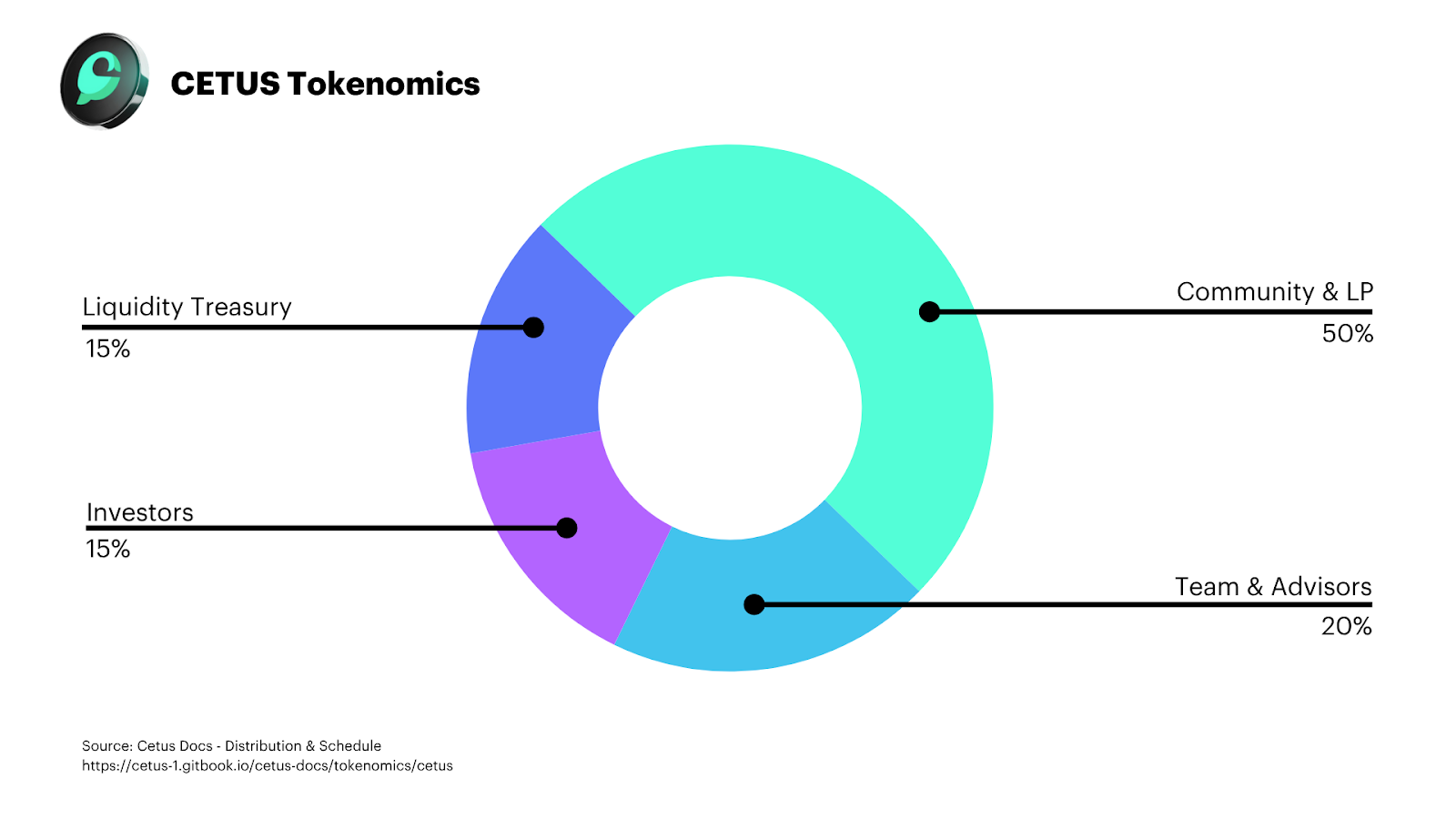
— Community & LP 50% — จัดสรรผ่านการขุด การทำฟาร์ม และเพื่อเป็นแรงจูงใจในการสร้างสภาพคล่องและแคมเปญการตลาด
— Team & Advisors 20% — แบ่งไว้สำหรับทีมผู้ร่วมพัฒนาและที่ปรึกษา โดยจะล็อกเอาไว้นาน 12 เดือน และ 24 เดือนสำหรับการจัดสรรตามช่วงเวลาหรือ Vesting
— Investors 15% — จัดสรรสำหรับนักลงทุน โดยจะล็อกไว้นาน 6 เดือน และ 12 เดือนสำหรับการจัดสรรตามช่วงเวลาหรือ Vesting
— Liquidity Treasury 15% — สำหรับสภาพคล่องเริ่มต้นและการบำรุงรักษาสภาพคล่องบน CEX/DEX ระยะยาว
ข้อมูลน่าสนใจด้านราคาของ CETUS

ข้อมูลจากเว็บไซต์ CoinMarketCap เมื่อวันที่ 18 มิถุนายน 2025 โทเคน CETUS มีมูลค่าตามราคาตลาด (Market cap) ที่ 75,265,232.86 ดอลลาร์สหรัฐฯ หรือประมาณ 2,451,415,391.57 บาท
ณ เวลาที่เขียนบทความนี้โทเคน CETUS ซื้อขายกันอยู่ที่ราคาประมาณ 0.09309 ดอลลาร์สหรัฐฯ หรือประมาณ 3.02 บาท ต่อ 1 CETUS โดย CETUS เคยทำราคาสูงสุด (All-time high) ที่ 0.4924 ดอลลาร์สหรัฐฯ หรือประมาณ 16.04 บาท ต่อ 1 CETUS เมื่อวันที่ 10 พฤศจิกายน 2024
ที่มา : Cetus Docs, CoinMarketCap
— — — — — — — — — — — — — — — — —
คำเตือน:
- คริปโทเคอร์เรนซีและโทเคนดิจิทัลมีความเสี่ยงสูง ท่านอาจสูญเสียเงินลงทุนได้ทั้งจํานวน โปรดศึกษาและลงทุนให้เหมาะสมกับระดับความเสี่ยงที่ยอมรับได้
- ผลตอบแทนของสินทรัพย์ดิจิทัลในอดีตหรือผลการดําเนินงานในอดีต มิได้เป็นสิ่งยืนยันถึงผลตอบแทน ของสินทรัพย์ดิจิทัลหรือผลการดําเนินงานในอนาคต
— — — — — — — — — — — — — — — — —

หากคุณยังเป็นมือใหม่ ค้นหาข้อมูลเพิ่มเติมได้ในบทความ “แหล่งความรู้ มือใหม่หัดเทรดคริปโต เริ่มต้นที่นี่” แล้วมาเริ่มต้นเทรดได้วันนี้ที่ Bitkub Exchange → คลิกสมัครเลย
— — — — — — — — — — — — — — — — —
Introducing CETUS CETUS (Cetus Protocol): Decentralized Liquidity Protocol on Sui and Aptos Networks
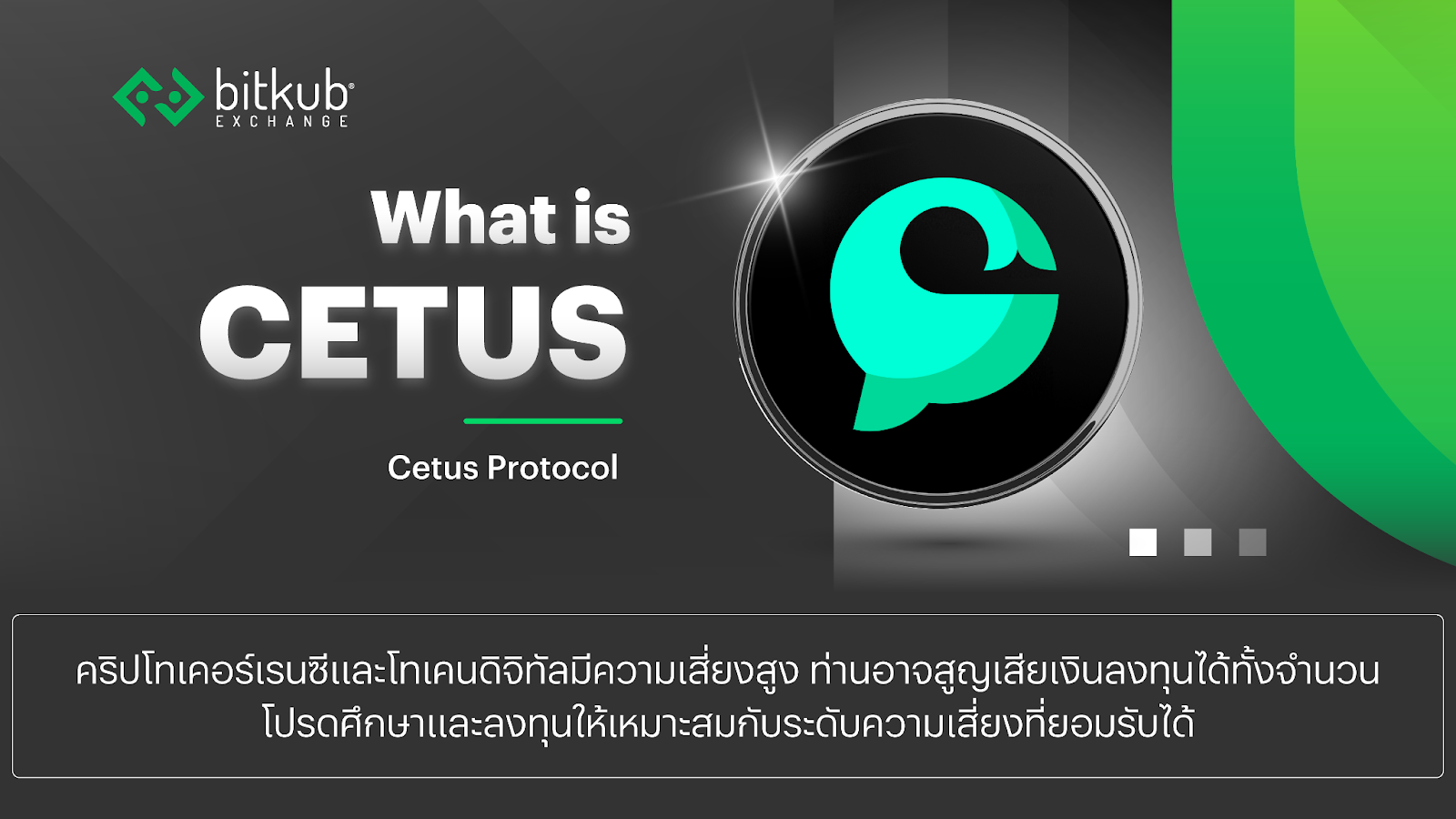
For those curious about the evolving landscape of decentralized finance (DeFi), Cetus Protocol has emerged as a significant player, offering innovative solutions for liquidity provision and trading. This article delves into the intricacies of Cetus Protocol, exploring its underlying technology, standout features, the role of its native CETUS token, and its detailed tokenomics.
What is Cetus Protocol and Its Technology?
Cetus Protocol is a pioneering decentralized exchange (DEX) and concentrated liquidity protocol built primarily on the Sui and Aptos blockchains. These layer-1 blockchains are known for their high throughput, low latency, and scalable infrastructure, providing a fertile ground for demanding DeFi applications like Cetus.
The core technological innovation of Cetus lies in its concentrated liquidity market maker (CLMM) model. Unlike traditional Automated Market Makers (AMMs) that distribute liquidity uniformly across the entire price curve (from zero to infinity), Cetus allows Liquidity Providers (LPs) to concentrate their capital within specific price ranges of their choosing. This approach leads to several key advantages:
— Higher Capital Efficiency: LPs can allocate their funds to price ranges where most trading activity occurs, earning more fees with less capital compared to traditional AMMs.
— Lower Slippage for Traders: Concentrated liquidity means deeper markets around the current trading price, resulting in reduced slippage for traders executing swaps.
— Customizable Liquidity Provision: LPs have granular control over their liquidity deployment strategies, enabling them to adapt to market conditions and maximize their returns.
Cetus Protocol leverages smart contracts to automate its operations, ensuring transparency, security, and permissionless interaction. Its architecture is designed to be highly flexible and composable, aiming to serve as a foundational liquidity layer for various DeFi applications and even integrate with Non-Fungible Token (NFT) markets by potentially supporting NFT swaps.
The protocol also promotes the concept of “Liquidity As A Service” (LaaS). This positions Cetus not just as a standalone DEX but as a fundamental infrastructure piece that other protocols and applications can build upon, easily integrating Cetus’s efficient liquidity pools into their own offerings.
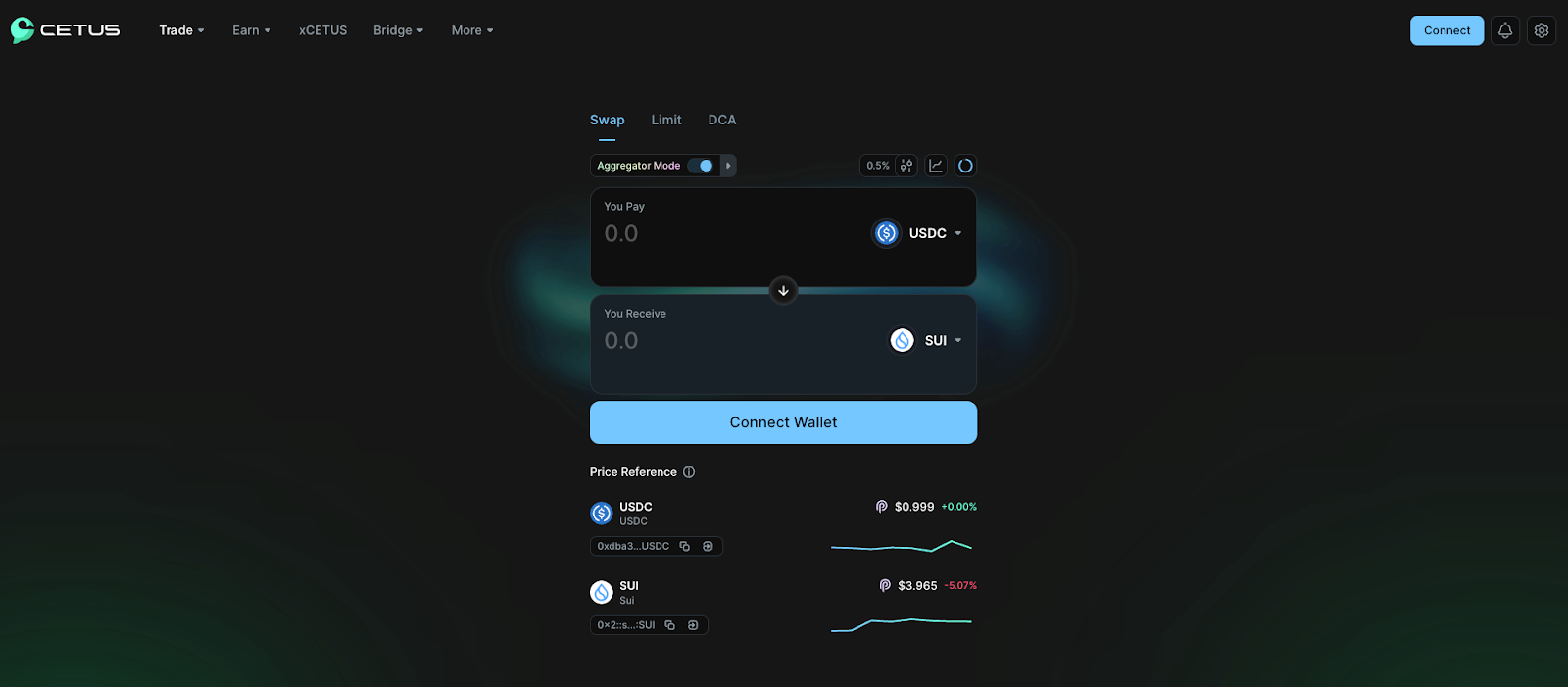
What are the Highlight Features?
Cetus Protocol distinguishes itself with several key features designed to enhance the user experience for both traders and liquidity providers:
— Concentrated Liquidity: As discussed, this is the cornerstone of Cetus, allowing for efficient use of capital and better trading execution.
— Permissionless Pools & Asset Listings: Anyone can create a new liquidity pool for any token pair or trade any listed asset, fostering an open and accessible DeFi ecosystem.
— Range Orders: LPs can provide single-sided liquidity within a specific price range above or below the current market price, effectively creating buy or sell limit orders that also earn fees once active.
— Programmable Liquidity: The protocol’s design allows for more sophisticated liquidity management strategies and integrations by developers.
— User-Friendly Interface: While offering advanced features, Cetus strives to provide an intuitive interface for users to easily swap tokens and manage their liquidity positions.
— Cross-Chain Aspirations: Initially built on Sui and Aptos, the underlying design principles and technology could potentially be adapted for other blockchain networks in the future.
— Double-Token Model (CETUS & xCETUS): This model is designed to provide sustainable incentives for active participants. xCETUS is often a staked or escrowed version of CETUS, granting governance rights and potentially a share of protocol fees.
— Focus on Sui and Aptos Ecosystems: By launching on these emerging high-performance blockchains, Cetus positions itself at the forefront of innovation within these rapidly growing DeFi ecosystems.
What is the Cetus Token (CETUS)?
The CETUS token is the native utility and governance token of the Cetus Protocol. It plays a crucial role in the functioning and development of the ecosystem:
— Governance: CETUS token holders can participate in the decentralized governance of the protocol. This includes voting on key parameter changes, protocol upgrades, and the allocation of treasury funds. This is often facilitated through staking CETUS to receive a governance token variant (like xCETUS).
— Incentivizing Liquidity Provision: CETUS tokens are used to reward liquidity providers who contribute their assets to Cetus Protocol’s liquidity pools. These rewards, often referred to as liquidity mining incentives, compensate LPs for the impermanent loss risk and encourage deep liquidity.
— Staking & Fee Sharing: Users can stake their CETUS tokens. By doing so, they can earn a share of the trading fees generated by the protocol and potentially receive additional CETUS rewards. Longer staking periods often result in greater voting power and higher reward rates, aligning with a veToken (vote-escrowed token) model.
— Medium of Exchange: Cetus is designed to be used as a medium of exchange within the network and is also interoperable.
Token Allocation and Tokenomics
The CETUS token has a maximum supply of 1,000,000,000 CETUS, which can be broken down as follows:
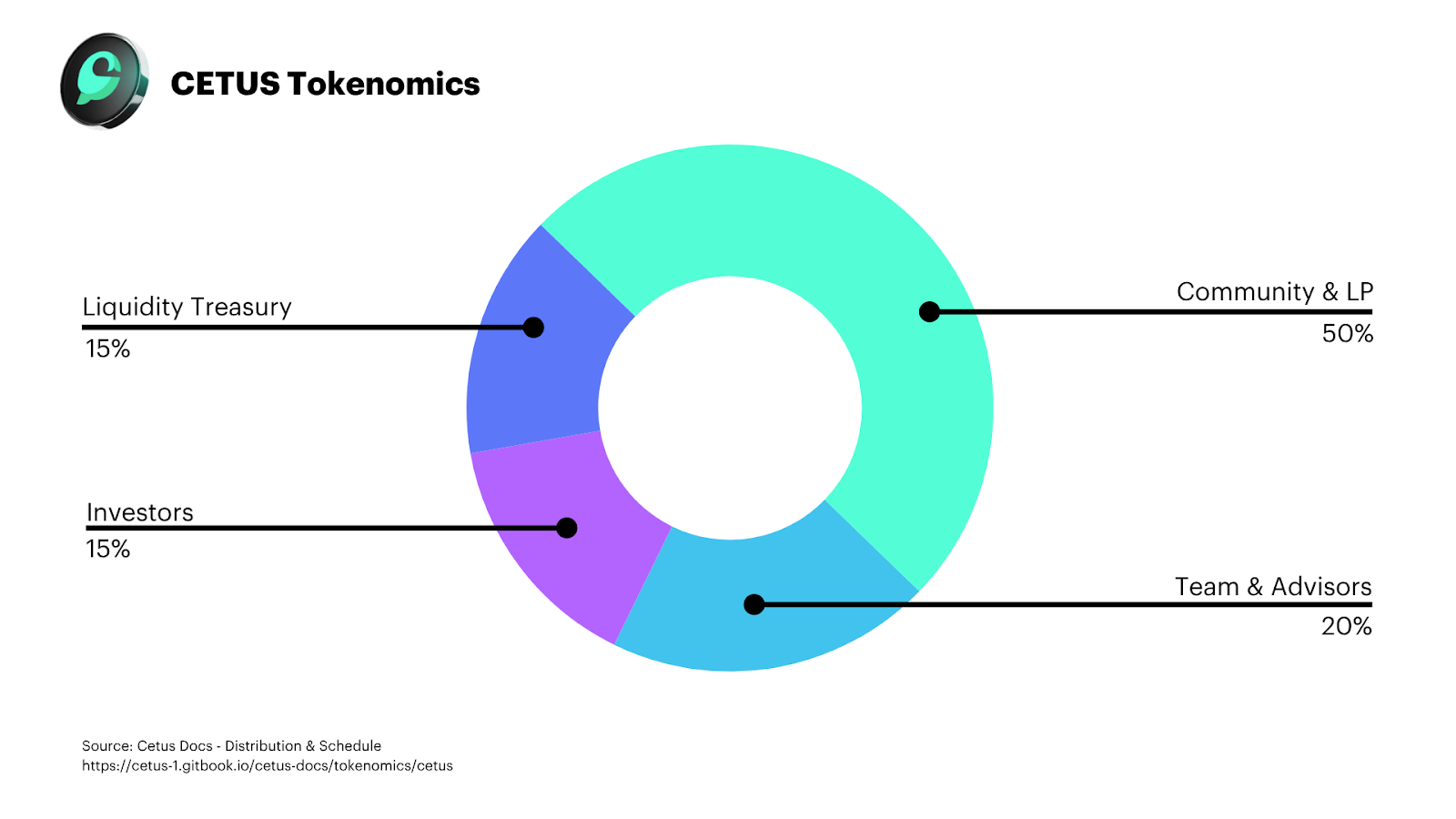
Community and Liquidity Providers (LP): 50% — This is the largest portion, designated for incentivizing users to provide liquidity, participate in yield farming programs, and engage with the protocol. This ensures a wide distribution and encourages active participation from the community.
Team and Advisors: 20% — Allocated to the core development team and strategic advisors who contribute to the creation and growth of the protocol.
Vesting Schedule: Subject to a 12-month cliff (locking period) followed by a 24-month linear monthly vesting schedule. This aligns the team’s long-term commitment with the project’s success.
Investors: 15% — Reserved for private and strategic fundraising rounds that provided initial capital for the project’s development.
Vesting Schedule — Subject to a 6-month cliff (locking period) followed by a 12-month linear monthly vesting schedule.
Liquidity Treasury: 15% — This portion is likely reserved for activities such as providing initial liquidity on exchanges, funding future partnerships, grants for ecosystem development, marketing initiatives, and other operational needs that support the protocol’s growth and stability.
Interesting Information Regarding CETUS Price

According to data from the CoinMarketCap website on June 17, 2025, the CETUS token had a market capitalization (Market cap) of $75,265,232.86 USD, or approximately 2,451,415,391.57 Thai Baht.
At the time of writing this article, the CETUS token was trading at approximately $0.09309 USD, or about 3.02 Thai Baht per 1 CETUS. CETUS reached its all-time high of $0.4924 USD, or approximately 16.04 Thai Baht per 1 CETUS, on November 10, 2024.
Reference: Cetus Docs, CoinMarketCap
— — — — — — — — — — — — — — — — —
Disclaimer:
-Cryptocurrency and digital tokens involve high risks; investors may lose all investment money and should study information carefully and make investments according to their own risk profile.
-Past Returns do not guarantee future returns/performance.
— — — — — — — — — — — — — — — — —

New to cryptocurrency trading? Our comprehensive guide, ‘A Beginner’s Guide to Crypto Trading: Your Starting Point,’ has all the information you need. Once you’re ready, you can begin your trading journey today at Bitkub Exchange. → Click here
ที่มา:
Medium